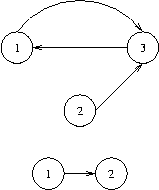| Time Limit: 3000MS | Memory Limit: 65536K | |
| Total Submissions: 10687 | Accepted: 4403 |
Description
We will use the following (standard) definitions from graph theory. Let V be a nonempty and finite set, its elements being called vertices (or nodes). Let E be a subset of the Cartesian product V×V, its elements being called edges. ThenG=(V,E) is called a directed graph.
Let n be a positive integer, and let p=(e1,...,en) be a sequence of length n of edges ei∈E such that ei=(vi,vi+1) for a sequence of vertices (v1,...,vn+1). Then p is called a path from vertex v1 to vertex vn+1 in G and we say that vn+1is reachable from v1, writing (v1→vn+1).
Here are some new definitions. A node v in a graph G=(V,E) is called a sink, if for every node w in G that is reachable from v, v is also reachable from w. The bottom of a graph is the subset of all nodes that are sinks, i.e.,bottom(G)={v∈V|∀w∈V:(v→w)⇒(w→v)}. You have to calculate the bottom of certain graphs.
Let n be a positive integer, and let p=(e1,...,en) be a sequence of length n of edges ei∈E such that ei=(vi,vi+1) for a sequence of vertices (v1,...,vn+1). Then p is called a path from vertex v1 to vertex vn+1 in G and we say that vn+1is reachable from v1, writing (v1→vn+1).
Here are some new definitions. A node v in a graph G=(V,E) is called a sink, if for every node w in G that is reachable from v, v is also reachable from w. The bottom of a graph is the subset of all nodes that are sinks, i.e.,bottom(G)={v∈V|∀w∈V:(v→w)⇒(w→v)}. You have to calculate the bottom of certain graphs.
Input
The input contains several test cases, each of which corresponds to a directed graph G. Each test case starts with an integer number v, denoting the number of vertices of G=(V,E), where the vertices will be identified by the integer numbers in the set V={1,...,v}. You may assume that 1<=v<=5000. That is followed by a non-negative integer e and, thereafter, e pairs of vertex identifiers v1,w1,...,ve,we with the meaning that (vi,wi)∈E. There are no edges other than specified by these pairs. The last test case is followed by a zero.
Output
For each test case output the bottom of the specified graph on a single line. To this end, print the numbers of all nodes that are sinks in sorted order separated by a single space character. If the bottom is empty, print an empty line.

Sample Input
3 3 1 3 2 3 3 1 2 1 1 2 0
Sample Output
1 3 2
Source
Ulm Local 2003
1 #include<iostream> 2 #include<cstring> 3 #include<cstdio> 4 #include<vector> 5 #include<algorithm> 6 #include<stack> 7 #define maxm 500010 8 #define maxn 5010 9 using namespace std; 10 int T,n,m; 11 struct edge{ 12 int u,v,next; 13 }e[maxm],ee[maxm]; 14 vector<int> kp[maxn],ans; 15 int head[maxn],js,headd[maxn],jss; 16 bool exist[maxn]; 17 int visx,cur;// cur--缩出的点的数量 18 int dfn[maxn],low[maxn],belong[maxn],chudu[maxn]; 19 stack<int>st; 20 void init(){ 21 memset(chudu,0,sizeof(chudu)); 22 memset(e,0,sizeof(e));memset(ee,0,sizeof(ee)); 23 memset(head,0,sizeof(head));memset(headd,0,sizeof(headd)); 24 jss=js=visx=cur=0; 25 memset(exist,false,sizeof(exist)); 26 while(!st.empty())st.pop(); 27 memset(dfn,0,sizeof(dfn));memset(low,0,sizeof(low)); 28 memset(belong,0,sizeof(belong)); 29 ans.resize(0); 30 for(int i=0;i<maxn;i++)kp[i].resize(0); 31 } 32 void add_edge1(int u,int v){ 33 e[++js].u=u;e[js].v=v; 34 e[js].next=head[u];head[u]=js; 35 } 36 void tarjan(int u){ 37 dfn[u]=low[u]=++visx; 38 exist[u]=true; 39 st.push(u); 40 for(int i=head[u];i;i=e[i].next){ 41 int v=e[i].v; 42 if(dfn[v]==0){ 43 tarjan(v); 44 low[u]=min(low[u],low[v]); 45 } 46 else if(exist[v]&&low[u]>dfn[v]) low[u]=dfn[v]; 47 } 48 int j; 49 if(low[u]==dfn[u]){ 50 ++cur; 51 do{ 52 j=st.top();st.pop();exist[j]=false; 53 kp[cur].push_back(j); 54 belong[j]=cur; 55 }while(j!=u); 56 } 57 } 58 void add_edge2(int u,int v){ 59 ee[++jss].u=u;ee[jss].v=v; 60 ee[jss].next=headd[u];headd[u]=jss; 61 } 62 void apki(int x){ 63 for(int i=0;i<kp[x].size();i++){ 64 int k=kp[x][i]; 65 ans.push_back(k); 66 } 67 } 68 int main() 69 { 70 while(scanf("%d%d",&n,&m)==2){ 71 init(); 72 int u,v; 73 for(int i=0;i<m;i++){ 74 scanf("%d%d",&u,&v);add_edge1(u,v); 75 } 76 for(int i=1;i<=n;i++){// 求强连通分量 77 if(dfn[i]==0) tarjan(i); 78 } 79 for(int i=1;i<=m;i++){ 80 int u=e[i].u,v=e[i].v; 81 if(belong[u]!=belong[v]){ 82 add_edge2(belong[u],belong[v]); 83 chudu[belong[u]]++; 84 } 85 } 86 for(int i=1;i<=cur;i++){ 87 if(chudu[i]==0) 88 apki(i); 89 } 90 sort(ans.begin(),ans.end()); 91 for(int i=0;i<ans.size();i++) printf("%d ",ans[i]); 92 printf(" "); 93 } 94 return 0; 95 }
思路:和POJ2762差不很多